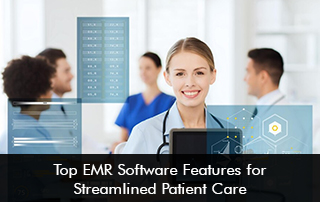EMR software has revolutionized how healthcare providers manage patient information and deliver care. EMR can improve efficiency, reduce errors, and enhance patient outcomes with the right features. Below, we explore the top Electronic Medical Records (EMR) software features that help streamline patient care.
What Is EMR Software?
EMR software is a digital solution for storing and managing patient health records. It replaces paper-based systems, offering healthcare providers easy access to patient data, efficient workflows, and tools to improve patient care.
Benefits of Using EMR Software
Better Patient Data Management
EMR systems store all patient information in one secure location. This makes it easier for providers to access and update records, ensuring data accuracy.
Improved Communication
EMR software enhances communication between healthcare providers, patients, and other stakeholders. This ensures that everyone involved in patient care stays on the same page.
Enhanced Efficiency
Features like automated reminders and streamlined workflows reduce administrative tasks, giving healthcare professionals more time to focus on patients.
Top EMR Features for Streamlined Patient Care
1. Intuitive User Interface
An easy-to-use interface ensures that healthcare providers can quickly navigate the EMR system without extensive training. A good interface should include:
- Customizable Dashboards: Personalized layouts to fit different roles within the practice.
- Quick Search Functions: Fast access to patient records or clinical tools with minimal clicks.
2. Comprehensive Patient Records
A robust EMR system should store and manage all relevant patient data, including:
- Demographics and Medical History: A full picture of the patient’s background.
- Immunization Records and Allergies: Critical for safe treatment plans.
- Medication Management: Helps track prescriptions, dosages, and refills.
3. EMR Software Appointment Scheduling and Reminders
Efficient scheduling tools reduce missed appointments and improve patient satisfaction. Key features include:
- Online Booking Options: Allow patients to schedule their appointments easily.
- Automated Reminders: SMS or email alerts to remind patients of upcoming visits.
- Integrated Calendar Management: Links with provider schedules for seamless planning.
4. Clinical Decision Support (CDS)
CDS tools assist healthcare providers in making evidence-based decisions by providing:
- Alerts and Reminders: Warn about potential drug interactions or allergies.
- Diagnostic Assistance: Suggest possible diagnoses based on symptoms and patient history.
- Guideline Integration: Provide access to the latest clinical protocols.
5. E-Prescribing (eRx)
E-prescribing improves medication accuracy and reduces errors. Essential features include:
- Direct Pharmacy Communication: Send prescriptions directly to pharmacies.
- Medication History Access: View a patient’s prescription history to avoid conflicts.
- Dosage and Interaction Checks: Ensure safe prescribing practices.
6. EMR Software Telemedicine Integration
With the rise of virtual care, telemedicine features have become vital. These include:
- Video Consultations: Secure, high-quality virtual appointments.
- Remote Patient Monitoring: Track chronic conditions or post-surgery recovery.
- Integrated Notes: Automatically store consultation notes in patient records.
7. Billing and Revenue Cycle Management
Efficient billing systems reduce errors and speed up payments. EMR billing tools often include:
- Insurance Verification: Check patient eligibility in real time.
- Claim Submission and Tracking: Submit claims electronically and monitor their status.
- Patient Payment Portals: Allow patients to pay bills online for convenience.
8. EMR Software Interoperability
EMR systems should integrate with other healthcare systems and devices. Interoperability ensures:
- Data Sharing Across Providers: Seamless communication between hospitals, labs, and specialists.
- Integration with Wearable Devices: Automatically import health data like heart rate or glucose levels.
9. Compliance and Security Features
Patient data security is critical. Key compliance features include:
- HIPAA Compliance: Ensure the system meets legal standards for data protection.
- Data Encryption: Protect sensitive information from cyber threats.
- Audit Trails: Track access and changes to patient records.
10. Analytics and Reporting
Analytics tools help healthcare providers track performance and improve care. Useful features include:
- Population Health Management: Identify trends and address gaps in care.
- Performance Metrics: Monitor practice efficiency and patient outcomes.
- Custom Reports: Generate tailored insights for decision-making.
11. EMR Software Patient Portal
A user-friendly patient portal empowers patients and improves engagement. Features include:
- Secure Messaging: Communicate with providers directly.
- Access to Records: View test results, visit summaries, and more.
- Appointment Management: Schedule visits and check upcoming appointments.
How to Choose the Right EMR Software
Selecting the best EMR system depends on your practice’s needs. Here’s a quick checklist:
- Identify Your Requirements: What features are non-negotiable for your practice?
- Check Vendor Support: Ensure they offer training and reliable customer support.
- Assess Scalability: Can the system grow with your practice?
- Read Reviews: Learn from other users’ experiences.
Final Thoughts
EMR software is an invaluable tool for improving patient care and streamlining practice operations. By focusing on the features mentioned above, healthcare providers can choose a system that enhances efficiency, supports decision-making, and prioritizes patient satisfaction.
In today’s fast-paced healthcare environment, investing in the right EMR solution isn’t just about keeping up with technology—it’s about delivering better care.
What features are most important to your practice? Share your thoughts in the comments below!







